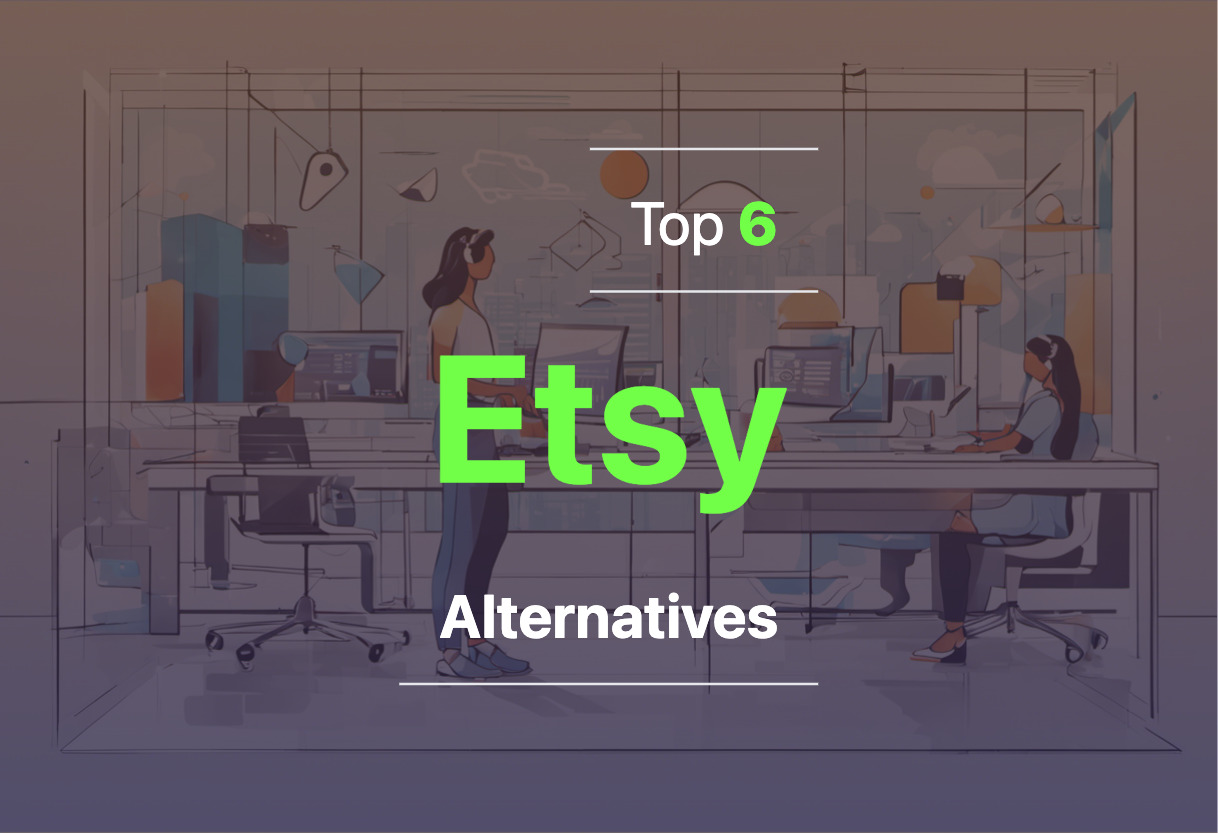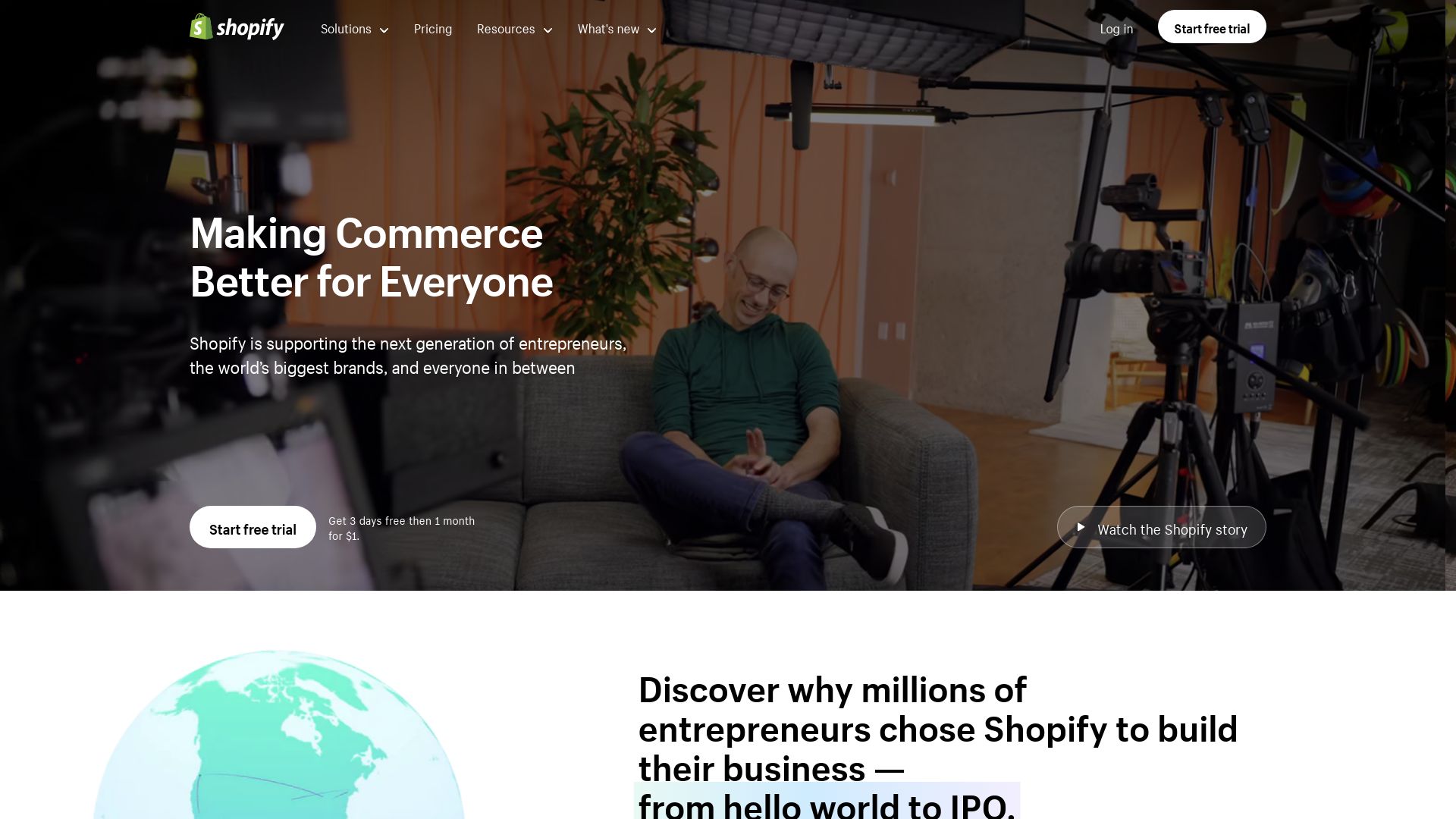Etsy is an online platform tailored for independent craftsmen and vintage collectors. With 4.3 million users, it offers a user-friendly interface, internal analytics, SEO optimization, and supportive community connections. Sellers benefit from easy logistics and in-app tools for order management and growth. Etsy’s main focus is on handcrafted goods and rare vintage items, catering to individuals and small-scale vendors.

For individuals looking for platforms beyond Etsy, alternatives encompass Shopify, Redbubble, BigCommerce, Squarespace, WooCommerce, and Poshmark.
Shopify

An eminent choice in the eCommerce panorama, Shopify offers an array of pre-made templates for the seamless design of eCommerce websites. Despite its limitations, Shopify manages to cater to a wide range of eCommerce businesses, from startups to established enterprises.
Shopify Top Features
- Array of pre-made templates
- Integration with custom ERP or CRM systems
- Possibility of custom-design themes
- Unique page templates for product pages, blog pages, etc.
- Key user retention features like search functionality, discount tools, carousel slides, and more
- Choice between native and headless builds
| Service | Features |
|---|---|
| Metizsoft Solutions, Eastside Co, Blend Commerce, OuterBox | eCommerce website design and development |
| Accelerator Programme by Eastside Co | Quick-launch solutions for merchants to launch stores |
Shopify Limitations
- Lacks brand-specific aesthetics in templates
- Does not provide custom website design services
- Custom design can be costly
- Increases cost due to the requirement of professional services for design and functionality
Shopify Pricing
The initial cost of a basic Shopify website design ranges between $500 – $1,000. However, a full-featured, custom-designed Shopify store may cost anywhere from $5,000 – $20,000. Extensive projects can even exceed the $100,000 mark. The cost also includes a monthly Shopify subscription ranging from $29.99 – $299.99.
Shopify Use Cases
Use case 1
For a new eCommerce business, Shopify offers quick-launch solutions via the Accelerator Programme. It enables merchants to establish their online store in less than four weeks.
Use case 2
For an existing eCommerce business aiming to redefine their digital presence, Shopify provides integration with custom ERP or CRM systems, and custom web design options.
Use case 3
Shopify also serves businesses wishing to enhance their user engagement with features such as wishlist creation, product reviews and more.
Redbubble
Since its inception in 2006, Redbubble has redefined the eCommerce space by offering a free-to-join marketplace that houses a wide variety of items from apparel and stationery to home décor. It’s an artist-driven space with over 800,000 artists contributing to its vast design range.
Redbubble Best Features
- Freedom of Pricing: Artists determine their product prices.
- Inventory Management: No inventory; products are made to order.
- Shop Customization: Artists can customize the appearance of their shops, including bio, avatar, and social links.
- Wide Range of Products: There are over 80 product types available.
| Attribute | Detail |
|---|---|
| Protection | SSL encryption is used to safeguard buyers’ information. |
| ecommerce Trust | Offers a 90-day money-back guarantee for all orders. |
| Shop Promotion | Redbubble encourages and guides sellers to strategically use tags and promote their stores. |
Redbubble Limitations
- Payments are only processed when earnings reach the $20 threshold, which could delay access to revenue for new sellers.
- Redbubble’s classification into Standard, Premium, and Pro tiers, depending on activity and success, can pose a disadvantage for those sellers not meeting specific criteria.
Redbubble Pricing
While Redbubble is a free-to-join platform, seller earnings are wholly dependent on the markup of the products being sold. Redbubble Premium and Pro members are not saddled with an account fee.
Redbubble Use Cases
Use Case 1
Emerging artists can leverage Redbubble for income generation and global exposure. With freedom in pricing and a wide market coverage, artists can reach customers in approximately 200 countries.
Use Case 2
For customers, Redbubble represents a hub of unique, independently designed products. From fashionistas to art enthusiasts, different audiences can find tailored designs to suit their niche interests.
Use Case 3
Licensing companies can partner with Redbubble to monetize fan art. By facilitating the sale of licensed fan art, both parties benefit from the shared revenues.
BigCommerce

An edifice in the realm of e-commerce, BigCommerce offers a comprehensive toolkit for online enterprises. Offering a suite of features from theme innovation to inventory management, it surpasses conventional online retail platforms.
BigCommerce Top Features
- Open API: Providing vast customization options with no prerequisite for coding knowledge.
- Responsive Design: Ensures cross-device compatibility, from desktop to mobile devices.
- Stencil Theme Platform: This operational evolution offers a WYSIWYG editor, enabling real-time theme modifications sans coding.
- HTML and CSS Editing: Further customization of themes is possible via HTML and CSS code alterations, with no disruption to store operations.
- Inventory Management: The presence of tools like abandoned cart recovery and analytics enhance control over inventory and sales.
| Features | Benefits |
|---|---|
| Open Source Code | Non-proprietary, freely modifiable, allowing developers full creative range. |
| Google AMP Compatible | Assures swift mobile page loads, boosting user experience and conversion rates. |
| Advanced Marketing Tools | Bundling of sales tools with features like blog tools augment marketing efforts. |
BigCommerce Downsides
- Operational difficulties can arise during instances of technological breakdowns, impacting sales.
- The platform might seem overwhelming for individuals with zero technical proficiency.
BigCommerce Pricing
BigCommerce follows a varied pricing model catering to different business sizes, with the goal of accelerating growth for all, from startups to enterprise-level domains. Always refer to their official website for accurate pricing details.
BigCommerce Use Cases
Use case 1: Small Businesses
For small businesses looking to dip their toes in the vast ocean of online retail, BigCommerce stands as a beacon. Its suite of tools simplifies adventure into e-commerce, making it a top contender amongst Etsy alternatives.
Use case 2: Mid-Market Entities
With BigCommerce, mid-market businesses can expand their horizon, steering their journey effortlessly toward higher conversions and greater profits.
Use case 3: Large Enterprises
For large businesses, the extensive customization options and robust toolkit offered by BigCommerce ensure sustainable expansion and success in the competitive world of online retail.
Squarespace
An unparalleled website builder platform, Squarespace delights users with its expertly crafted templates, ecommerce capabilities, and tight-knit tools for online presence.
Squarespace Top Features
- Immaculate website templates
- Blueprint for customizing template designs
- Comprehensive ecommerce tools and platform
- Email campaigns and Social media marketing
- 24/7 customer support
- Integrative analytic tools
- Platform to manage unlimited physical and digital products
| Feature | Benefit |
|---|---|
| Squarespace Commerce | Specialized online store platform, no transaction limits |
| Squarespace Extensions | Access to a curated app store |
| Mailchimp Integration | Email marketing campaign capability |
Squarespace Limitations
- Limited Squarespace Extensions
- Shipping connected only via third-party carriers
- Customer support limited to email, Twitter, and live chat
Squarespace Pricing
While exact pricing details aren’t provided here, Squarespace offers a range of plans to suit diverse needs. Some features are available only on advanced plans; check their website for more information.
Squarespace Use Cases
Use case 1: Professional Blogging
Squarespace houses a robust blogging platform to drive customer engagement and share industry knowledge.
Use case 2: Online Store
Sell products, digital or physical, seamlessly with the comprehensive ecommerce tools and intelligent inventory management of Squarespace.
Use case 3: Appointment Scheduling
Squarespace allows for scheduling appointments, selling classes, and membership sites, making it an asset for businesses operating in the service industry.
WooCommerce

As an open-source ecommerce platform, WooCommerce comes with an array of customization options for high-volume stores, housing around 3.9M online stores. It’s responsible for 23% of top 1M ecommerce sites.
WooCommerce Top Features
- Store building and customization
- Compatibility with WordPress (43% of the web)
- Conversion of existing WordPress site into an online store
- Excellent user experience and aesthetically pleasing designs
| Benefits | Key Features |
|---|---|
| Security | Inventory & Order Management |
| Tracking/Reporting | Tax Rates |
| 140+ Payment Gateway Integration | Coupon Creation |
WooCommerce Limitations
- Compatible only with WordPress websites
- Requires manual setup and customization(some handled by TheeDigital)
- Complex settings may be overwhelming for beginners
WooCommerce Pricing
Being an open-source platform, WooCommerce is free. However, certain extensions and themes come with a cost.
WooCommerce Use Cases
Use case 1
For businesses looking to build a user-friendly and flexible online store on a WordPress site.
Use case 2
High-volume stores craving for full customization and mobile-ready designs.
Use case 3
Retailers seeking advanced features like secure payment portals, live chat, conversion tracking, and social media integration.
Poshmark
Founded by Manish Chandra in 2011, Poshmark is a conspicuous name in the online marketplace panorama. It started as a platform for new and pre-owned fashion, but has snowballed into a multi-billion dollar business, jostling with titans like eBay and Etsy.
Poshmark Top Features
- Brand Closet program: Adequate for brands and retailers of all sizes
- Social interactions: Facilitates networking and communication with features like follow, like, share, and comment on listings
- Curated Shopping Experience: Browse diverse listings through comprehensive filters
- Closet Insights: Detailed sales analytics for sellers
- Third-party Logistics Integration Support: Beneficial for high volume sales operation
| Delivery | User Experience |
|---|---|
| Flat-rate US domestic shipping with USPS Priority base | Clean, modern user interface |
| Prepaid postage labels for sellers | Mobile app and website interface equipped with functionalities like following brands and sellers |
Poshmark Limitations
- Strict Return Policy: Only valid for counterfeit items or mismatched descriptions
- Limited Global Reach: Concentrated market in United States, Canada, Australia, UK, India
- User Negotiations: Sellers need to negotiate prices with buyers privately.
Poshmark Pricing
Poshmark operates on a commission-based model. There is a flat commission of $2.95 for sales under $15. For any sale over that, the seller keeps 80% of the earnings while Poshmark holds a 20% commission.
Poshmark Use Cases
Use Case 1: Sustainable Retail
With Poshmark, second-hand retail is gaining momentum. It aids in the sustainable trend through a collection of pre-owned products, redefining the perception of used apparel.
Use Case 2: Fashion Moguls
From casual sellers to fashion business owners, Poshmark is a platform where individuals can turn into stylists. Its flexible model invites anyone to curate and sell, enabling fashion enthusiasts to monetize their taste and inventory.
Use Case 3: Millennial and Gen Z Shoppers
Poshmark speaks to the environmental and budget concerns of Millennials and Gen Z. With a plethora of options and easy-to-navigate interface, it attracts younger audiences effortlessly.
Patrick Daugherty
Content writer @ Aircada. Merging AR expertise with a love for late-night gaming sessions.





